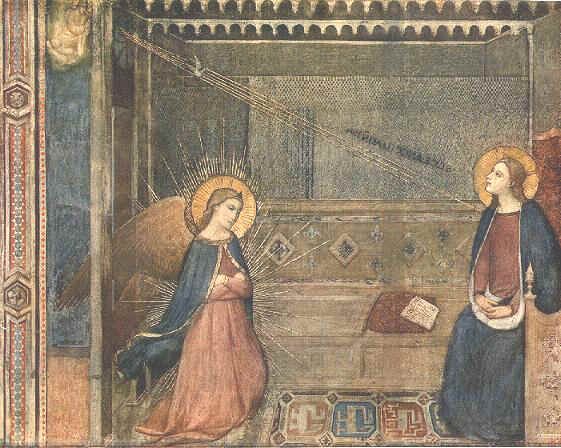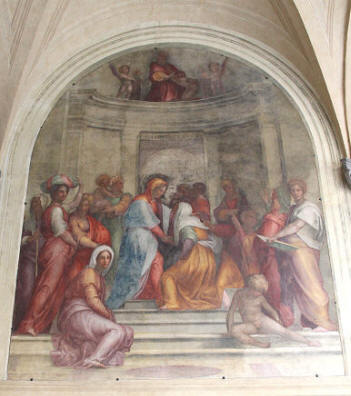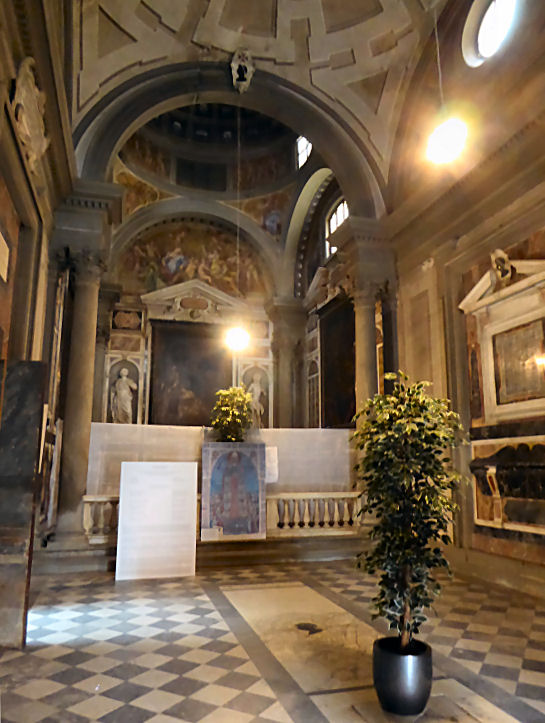|
History Santa Maria in Carfaggio, the mother church of the Servite order, the only religious order to originate in Florence, founded on 1233 by seven Florentine merchants, was built here in the 13th century on the site of an earlier monastery which had been abandoned by Franciscans when Santa Croce was built. The foundation stone was laid on March 25th 1250 and in 1252, so later legend has it, an Annunciation was painted by a monk called Bartolomeo, supposedly with the help of an angel who completed the fresco by painting the Virgin's face while the artist fitfully slept, having given up in despair of getting it right. The image's developing cult and miracle-working reputation led to the church's rededication in 1314, to the Most Holy Virgin of the Annunciation, and a need for expansion. Florence's fascination with The Annunciation is said to date from this painting too. The city then celebrated the beginning of the New Year on the feast day of the Annunciation, 25th March.  Around this time also began the fad for visitors leaving life-size and lifelike wax effigies of themselves wearing their own clothing and jewellery. These were hung in the nave, aisles, upper galleries and the forecourt, called the Ciostrino dei Voti. By the middle of the 1400s there were so many as to threaten the integrity of the church. By the 17th century more than 600 of these votive figures filled the atrium, including one of Lorenzo the Magnificent by Verrocchio and fully-armoured figures of condottieri Pippo Spano and Gattamelata, the latter on a wax horse. They are all now lost, having been melted down to make candles in 1786. A more major rebuilding took place between 1444 and 1455 to designs by Michelozzo who was the brother of the prior. An argument regarding his polygonal choir, or maybe just the time he was taking, led to Michelozzo being sacked in 1455 by Lodovico Gonzaga from Mantua who was providing the funding. First Manetti and later Alberti were then employed, the latter transforming Michelozzo's polygonal choir into a rotunda with nine radiating chapels capped by a solid concrete dome. Work finished in 1476. The façade loggia was built 1601-4 by Giovanni Caccini echoing Sangallo's central arch and matching the flanking loggias in the piazza.  The
atrium The
atriumPontormo's Visitation (see right) for which he was paid the meagre, for Vasari, sum of 16 scudi, is the highlight of the now-covered entrance atrium (see far right) known as the Ciostrino dei Voti as it was filled with wax votive offerings, it is something of an argument for Mannerism's ability to impress, although it is still very Raphael-inspired. The scene in the arch above is The Sacrifice of Isaac. Pontormo was buried under his fresco, but his body was moved to the chapel devoted to artists by Fra Giovan Angelo Montorsoli in 1562, under the Trinity painted by Bronzino, his pupil, and Allori. The decoration of the cloister had begun with works by Baldovinetti and Rosselli. Fifty years later Rosselli's work was continued with five frescoes by Andrea del Sarto (Pontormo and Rosso's master) from the life of Saint Filippo Benizzi, his first public commissions from 1509-10 and opposite his two scenes from the life of the virgin, The Journey of the Magi and the Nativity of the Virgin, painted later, from 1513. The latter is the better of the two, looking to have been very influenced by Ghirlandaio's Tornabuoni Chapel frescos in Santa Maria Novella. The Journey of the Magi, Pontormo's Visitation and the Assumption of the Virgin by Rosso were all removed and restored and grouped in the marvellous first room of the 2014 Pontormo and Rosso exhibition at the Strozzi. Also here is Franciabigio's Marriage of the Virgin which was painted in 1513. Vasari tells us that Franciabigio was so angry with the Servite brothers for uncovering the fresco before it was finished that he attacked some of the heads, including the Virgin’s, with a mason's hammer. Franciabigio was ordered to repair the fresco but this was apparently ignored, as the damage is still clearly visible. The recent restoration of the frescoes in the atrium was completed in 2017. Interior An impressively confusing dark and dusty-grey space, with much gilding, the mostly Baroque church interior dates to late 17th century and is by Michelozzo. It has connected chapels up each side and an OTT main altar with chapels in a semi-circular choir behind. There's an unsignposted door to this choir in the left transept, and I recommend it as there are good views from behind the altar and some superior (if unlabelled) altarpieces around the choir, by Bronzino and Giambologna amongst others. The tabernacle of 1449 near the entrance was also built to designs by Michelozzo, although Pagno di Lapo Portagiani 'was the master who made it' according to an inscription beneath the cornice at the back. This inscription also records that it was made at the expense of Piero de' Medici. The original marble altar, made at the same time as the tabernacle, is now in the Museo Bardini. The wooden cupola was added in the mid-17th Century. The richly ornamented tabernacle frames the miraculous image of The Annunciation of c. 1340, frescoed onto the inner façade wall. In the later 14th century this became the foremost of the many image cults of the period due both to its integration into civic religious ceremonies and its patronage by the Medici family. The face of the Virgin was said to have been painted by an angel, or even God, as a true image of the Virgin, whilst the painter dozed off in frustration. Vasari named the artist as Pietro Cavallini from Rome, and described him as almost a saint himself. Andrea del Castagno's fresco depicting the Apparition of the Trinity with Saints Jerome, Paula and Eustochium was commissioned by Girolamo Carboli for his chapel here, second on the left. It was mentioned by Vasari in the 1550 edition of The Lives... but was not visible by the time of the 1568 edition. It was eventually discovered in 1899, under a picture by Bronzino. During the restoration following the 1966 flood a sinopia was discovered differing much from the finished fresco.  Veit Stoss's limewood statue of San Rocco in
this church commissioned by Girolamo di Domenico Boccianti around 1523, was described by Vasari as ‘a miracle in wood’. Veit Stoss's limewood statue of San Rocco in
this church commissioned by Girolamo di Domenico Boccianti around 1523, was described by Vasari as ‘a miracle in wood’.The inlaid 15th-century cupboards in the sacristy came from the demolished monastery of San Pier Maggiore. Restoration work has revealed some remains of 14th-century frescoes. To the right of the entrance, still under the loggia, is the door to the oratory of San Sebastiano (see right) built for the Pucci family in 1452 to designs by Michelozzo. The presbytery was rebuilt in 1608 to a design by Giovanni Caccini and finished by Gherardo Silvani. The vault has frescoes by Poccetti and there are panels by Paggi and Lomi. The altarpiece is a Birth of the Virgin by Cigoli. It was for this oratorio that the Pollaiolo brothers painted The Martyrdom of Saint Sebastian, now in the National Gallery. See Lost art below. The large Choistro dei Morti (see far right) is mostly occupied by the Istituto Geografico Militare, Italy's national mapping agency. The fresco lunettes are nearly all from the early 17th and mostly by Bernardino Poccetti. The lunette above the door into the left transept of the church, is the Madonna del Sacco by Andrea del Sarto from 1525. The cloister also contains the Chapel of the Artists, or Chapel of Saint Luke, in use since 1565, used by the confraternity founded by Cosimo I and Vasari in 1563, where various 16th-century painters, including Pontormo and Benvenuto Cellini, are buried in the crypt. The last burial was in 1987, that of Rodolfo Siviero, president of the Academy and minister for the recovery of the art stolen by the Nazis inWWII. Vasari's Saint Luke Painting the Virgin, with himself immodestly depicted as St Luke, was painted for this chapel, and remains here. Other works here include Pontormo’s Holy Family of c.1514, painted for church of St. Ruffillo and frescoes by Alessandro Allori and Santi di Tito. During the Napoleonic suppressions the chapel was rebuilt for the private use of Bishop Eustachio d'Osmond, work which involving closing off the original entrance and moving the altar to under the Vasari fresco, as well as the installing in the ceiling Luca Giordano's Apparition of the Virgin to Saint Bernard. It’s currently used by professors from the Accademia delle Arti del Disegno for religious functions, including mass on St Luke’s Day on October 18th. Update May 2022 The chapel has just emerged from two years of restoration work, but there's been no news of its opening to the public.
Buried
here Lost art A tall panel depicting Mary Magdalen and Eight Scenes from her Life by the Magadalen Master, from c.1280, is now in the Accademia. There are six panels from an altarpiece by Agnolo Gaddi in the Alte Pinakotek in Munich from c.1393/96. Two panels from the main register are full-length Saints Julian and Nicholas, with the four predella panels showing scenes from the two saints' lives, two each. They were thought to have come from the chapel devoted to Saint Nicholas here, but a recent theory has the altarpiece being commissioned by banker and merchant Gabriello Panciatichi for San Basilio. The sinopia (underdrawing) of Andrea Castagna's fresco The Vision of Saint Jerome between Saints Paula and Eustochium is now installed in the Cenacolo (refectory) of Sant'Appollonia. Paula and Eustochium being mother and daughter nuns who studied and collaborated with Saint Jerome. Panels for a cabinet to protect the church's silver offerings, commissioned by Piero de' Medici from Fra Angelico and completed in 1448. They featured forty scenes from the Life of Christ, all the same size, with one double-sized panel. Of the thirty-five remaining panels, now in the San Marco Museum, three (The Marriage at Cana, The Baptism and The Transfiguration) are now thought to be early works by Alesso Baldovinetti, the rest are by Fra Angelico. Christ with the Four Evangelists by Fra Bartolomeo, now in the Galleria Palatina, with its two side panels to be found in the Galleria dell'Accademia. The famous Martyrdom of Saint Sebastian, completed c. 1475, by Antonio and Piero del Pollaiuolo (arguably their masterpiece, see right) was originally painted for Antonio Pucci, a Medici employee, for their oratory here, dedicated to Saint Sebastian. Roberto Pucci, an ancestor, removed it from the oratory, supposedly to be restored, but in 1857 he sold it to the National Gallery in London, where it remains. Filippino Lippi’s high altarpiece of The Deposition was begun in 1503 and after Lippi's death that year completed by his workshop successor Pietro Perugino, who was responsible for the calmer bottom half of the painting. It is now in the first room of the Accademia. It was the main panel on the front, the Assumption panel which faced the choir is still here. Of the side panels Saints John and Lucy by Perugino, subdued in colour and somewhat drugged-looking, are now in the Met in New York. Saint Margaret of Antioch (or Helen?) and The Blessed Francis of Siena are at the Lindenau-Museum in Altenburg, Saint Catherine of Alexandria is in a private collection in South Africa and San Filippo Benizzi is in the Borghese Gallery in Rome. Four predella panels are in the Art Institute of Chicago and one in the MET. The panels were dispersed in 1654. The altarpiece is said by Vasari to have had two painted curtains by the young Andrea del Sarto. Lorenzo di Credi's Nativity, (c.1496-1500) with his favoured version of the Baby lying on a symbolic bundle of grain, now in the Accademia is thought to have been painted for the chapel of the Blessed Gioacchino Piccolomini here. Piero di Cosimo's Incarnation with Saints Philip Benizzi, John the Evangelist, Catherine of Alexandria, Margaret, Peter and Antoninus Pierozzi from c.1504 which was originally in the Tebaldi Chapel here, dedicated to Saint John the Evangelist, is now in the Uffizi. Philip Benizzi, the founder of the Servites, and Antoninus Pierozzi, a late Bishop of Florence, have rays emanating from their heads rather than haloes as they had not yet been beatified.  Antonio del Ceraiolo's Archangel Michael is in the Andrea del Sarto
Cenacolo Museum at
San Salvi. Andrea del Sarto's own Annunciation, intended
as the lunette of an altarpiece painted in 1528 for the high altar of the
church of San Domenico in Sarzana, having been commissioned by Benedetto
Celsi, was, according to
Vasari, kept by Giuliano Scala, who had ordered the altarpiece for Celsi
and had ended up out of pocket. It hung in the Scala chapel here until
1580 when it was acquired from the family by Cardinal Ferdinando de’
Medici. A copy by Alessandro Allori (now in the Louvre) was substituted.
The original, its lunette shape squared off with added painted curtains,
is now in the Pitti. Andrea's main panel The Virgin in Glory with Saints,
ended up in the Gemaldegalerie in Berlin, where it was presumed destroyed in the Friedrichshain
flak tower (flakturm) fires of May 1945. A 19th century
German print of it (see right) is in the British Museum. Antonio del Ceraiolo's Archangel Michael is in the Andrea del Sarto
Cenacolo Museum at
San Salvi. Andrea del Sarto's own Annunciation, intended
as the lunette of an altarpiece painted in 1528 for the high altar of the
church of San Domenico in Sarzana, having been commissioned by Benedetto
Celsi, was, according to
Vasari, kept by Giuliano Scala, who had ordered the altarpiece for Celsi
and had ended up out of pocket. It hung in the Scala chapel here until
1580 when it was acquired from the family by Cardinal Ferdinando de’
Medici. A copy by Alessandro Allori (now in the Louvre) was substituted.
The original, its lunette shape squared off with added painted curtains,
is now in the Pitti. Andrea's main panel The Virgin in Glory with Saints,
ended up in the Gemaldegalerie in Berlin, where it was presumed destroyed in the Friedrichshain
flak tower (flakturm) fires of May 1945. A 19th century
German print of it (see right) is in the British Museum. A small Pieta panel of c.1515 by Andrea del Sarto, mentioned by Vasari and said to have been in a room in the convent here, along with a lost Nativity, was recently (Burlington magazine March 2024) identified as a panel now in a private collection.
The church in art |
|
|